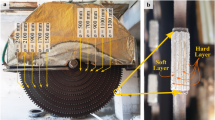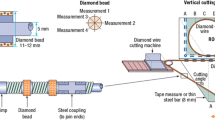Abstract
The great success and widespread use of impregnated diamond (ID) bits are due to their self-sharpening mechanism, which consists of a constant renewal of diamonds acting at the cutting face as the bit wears out. It is therefore important to keep this mechanism acting throughout the lifespan of the bit. Nonetheless, such a mechanism can be altered by the blunting of the bit that ultimately leads to a less than optimal drilling performance. For this reason, this paper aims at investigating the applicability of artificial intelligence-based techniques in order to monitor tool condition of ID bits, i.e. sharp or blunt, under laboratory conditions. Accordingly, topologically invariant tests are carried out with sharp and blunt bits conditions while recording acoustic emissions (AE) and measuring-while-drilling variables. The combined output of acoustic emission root-mean-square value (AErms), depth of cut (d), torque (tob) and weight-on-bit (wob) is then utilized to create two approaches in order to predict the wear state condition of the bits. One approach is based on the combination of the aforementioned variables and another on the specific energy of drilling. The two different approaches are assessed for classification performance with various pattern recognition algorithms, such as simple trees, support vector machines, k-nearest neighbour, boosted trees and artificial neural networks. In general, Acceptable pattern recognition rates were obtained, although the subset composed by AErms and tob excels due to the high classification performances rates and fewer input variables.







Similar content being viewed by others
Abbreviations
- AE:
-
Acoustic emissions
- AErms :
-
Acoustic emission root-mean-square value
- AI:
-
Artificial intelligence
- ANN:
-
Artificial neural networks
- b :
-
Bias parameters in SVM
- BT:
-
Boosted trees
- d :
-
Depth of cut
- DAQ:
-
Data acquisition card
- ID:
-
Impregnated diamond
- K :
-
Number of points inside the selected region for KNN method
- KNN:
-
K-nearest neighbour
- MLP:
-
Multi-layered perceptron
- MWD:
-
Measuring while drilling
- n :
-
Number of drilling tests
- P(X):
-
The probability density in the multi-dimensional spaces of KNN
- SE:
-
Specific energy
- ST:
-
Simple trees
- SVM:
-
Support vector machines
- tob:
-
Torque-on-bit
- V :
-
Rate of penetration
- V :
-
Volume of the selected region in KNN method
- wob:
-
Weight-on-bit
- X :
-
Multidimensional input vector
- Z :
-
Number of points within an AE signal
- Θ :
-
Weight coefficients vector
- φ(X):
-
Fixed feature-space transformation
- Ω :
-
Rotary speed
References
Baranov V, Kudryavstev E, Sarychev G, Schavelin V (2007) Acoustic emission in friction vol 53. Tribology and interface engineering series. Elsevier, ISSN 0167-8922
Bhatnagar A, Khandelwal M, Rao KUM (2011) Laboratory investigations for the role of flushing media in diamond drilling of marble. Rock Mech Rock Eng 44:349–356. doi:10.1007/s00603-011-0144-7
Bishop CM (2007) Pattern recognition and machine learning. Springer, New York
Borri-Brunetto M, Carpinteri A, Invernizzi S (2003) Characterization and mechanical modeling of the abrasion properties of sintered tools with embedded hard particles. Wear 254:635–644
Bullen GJ (1984) Hard rock drilling—some recent test results. Ind Diamond Rev 44:270–275
Bullen GJ (1985) Rock-hard tribology. Ind Lubr Tribol 37:44–76
Byrne G, Dornfeld D, Inasaki I, Ketteler G, König W, Teti R (1995) Tool condition monitoring (TCM)—the status of research and industrial application. CIRP Ann Manuf Technol 44:541–567. doi:10.1016/S0007-8506(07)60503-4
Chiaia B, Borri-Brunetto M, Carpinteri A (2013) Mathematical modelling of the mechanics of core drilling in geomaterials. Mach Sci Technol 17:1–25. doi:10.1080/10910344.2012.747881
Cortes C, Vapnik V (1995) Support-vector networks. Mach Learn 20:273–297. doi:10.1023/A:1022627411411
Damodarasamy S, Raman S (1993) An inexpensive system for classifying tool wear states using pattern recognition. Wear 170:149–160. doi:10.1016/0043-1648(93)90235-E
Detournay E, Defourny P (1992) A phenomenological model for the drilling action of drag bits. Int J Rock Mech Min Sci 29:13–23. doi:10.1016/0148-9062(92)91041-3
Detournay E, Richard T, Shepherd M (2008) Drilling response of drag bits: Theory and experiment. Int J Rock Mech Min Sci 45:1347–1360. doi:10.1016/j.ijrmms.2008.01.010
Franca LFP, Mostofi M, Richard T (2015) Interface laws for impregnated diamond tools for a given state of wear. Int J Rock Mech Min Sci 73:184–193. doi:10.1016/j.ijrmms.2014.09.010
Friedman JH (2001) Greedy function approximation: a gradient boosting machine. Ann Stat 29:1189–1232. doi:10.2307/2699986
Gómez MP, Hey AM, Ruzzante JE, D’Attellis CE (2010) Tool wear evaluation in drilling by acoustic emission. Phys Proc 3:819–825. doi:10.1016/j.phpro.2010.01.105
Gradl C, Eustes AW, Thonhauser G (2011) An analysis of noise characteristics of drill bits. J Energy Resour Technol 134:013103. doi:10.1115/1.4005324
Hardy HR (2003) Acoustic emission/microseismic activity. Taylor & Francis, The Netherlands, ISBN 9061918618
Huang SL, Wang ZW (1997) The mechanics of diamond core drilling of rocks. Int J Rock Mech Min Sci 34:134.e131-134.e114. doi:10.1016/S1365-1609(97)00233-5
Jemielniak K, Otman O (1998) Tool failure detection based on analysis of acoustic emission signals. J Mater Process Technol 76:192–197. doi:10.1016/S0924-0136(97)00379-8
Jung SJ, Prisbrey K, Wu G (1994) Prediction of rock hardness and drillability using acoustic emission signatures during indentation. Int J Rock Mech Min Sci 31:561–567. doi:10.1016/0148-9062(94)90159-7
Kannatey-Asibu E Jr, Dornfeld DA (1982) A study of tool wear using statistical analysis of metal-cutting acoustic emission. Wear 76:247–261. doi:10.1016/0043-1648(82)90009-6
Karakus M, Perez S (2014) Acoustic emission analysis for rock–bit interactions in impregnated diamond core drilling. Int J Rock Mech Min Sci 68:36–43. doi:10.1016/j.ijrmms.2014.02.009
Kassim AA, Mian Z, Mannan MA (2004) Connectivity oriented fast Hough transform for tool wear monitoring. Pattern Recogn 37:1925–1933. doi:10.1016/j.patcog.2004.01.014
Klaic M, Staroveski T, Udiljak T (2014) Tool wear classification using decision trees in stone drilling applications: a preliminary study. Proc Eng 69:1326–1335. doi:10.1016/j.proeng.2014.03.125
Li X (2002) A brief review: acoustic emission method for tool wear monitoring during turning. Int J Mach Manuf 42:157–165. doi:10.1016/S0890-6955(01)00108-0
Li Z, Itakura K (2012) An analytical drilling model of drag bits for evaluation of rock strength. Soils Found 52:216–227. doi:10.1016/j.sandf.2012.02.002
Maurer WC (1966) The state of rock mechanics knowledge in drilling. In: Fairhurst C (ed) Failure and breakage of rock: proceedings of the 8th symposium on rock mechanics. AIME, University of Minnesota, pp 355–395
Michigan State University (2015) Decision trees. http://www.cse.msu.edu/~cse802/DecisionTrees.pdf. Accessed 25 May 2015
Miller D (1986) Rock drilling with impregnated diamond microbits. University of Cape Town
Miller D, Ball A (1991) The wear of diamonds in impregnated diamond bit drilling. Wear 141:311–320. doi:10.1016/0043-1648(91)90276-Z
Mitchell TM (1997) Machine learning. McGraw-Hill, New York
Mostofi M (2014) Drilling response of impregnated diamond bits: modelling and experimental investigations. Curtin University
Mostofi M, Franca LFP, Richard T (2013) Drilling response of impregnated diamond bits: an experimental investigation. In: Paper presented at the 47th US rock mechanics/geomechanics symposium, San Francisco, CA (in press)
Perez S, Karakus M (2015a) An artificial neural network approach for the prediction of abrasivity of hard rocks using acoustic emission. In: Schubert W, Kluckner A (eds) Eurock 15 and 64th geomechanics colloquium, Salzburg, Austria, 11/06/2015, pp 285–290
Perez S, Karakus M (2015b) The influence of mineral contents of granitic rock on the acoustic emission during single contact abrasivity test. In: Paper presented at the 13th international symposium on rock mechanics Montreal, Canada, 10/05/2015
Perez S, Karakus M, Sepulveda E (2015) A preliminary study on the role of acoustic emission on inferring Cerchar abrasivity index of rocks using artificial neural network. Wear 344–345:1–8. doi:10.1016/j.wear.2015.10.006
Russell SJ, Norvig P (2010) Artificial intelligence: a modern approach, 3rd edn. Prentice Hall, Sydney
Shen HW, Hardy HR, Khair AW (1997) Laboratory study of acoustic emission and particle size distribution during rotary cutting. Int J Rock Mech Min Sci 34:121.e121-121.e116. doi:10.1016/S1365-1609(97)00247-5
Sun XQ (1999) A study of acoustic emission in drilling applications. In: Paper presented at The 37th US symposium on rock mechanics: rock mechanics for industry (USRMS), Vail, CO
Teale R (1965) The concept of specific energy in rock drilling. Int J Rock Mech Min Sci Geomech Abstracts 2:57–73. doi:10.1016/0148-9062(65)90022-7
Tian X, Tian S (1994) The wear mechanisms of impregnated diamond bits. Wear 177:81–91. doi:10.1016/0043-1648(94)90120-1
Tou JT, Gonzalez RC (1974) Pattern recognition principles. Addison-Wesley, Reading
Vardhan H, Kumar BR (2013) Application of artificial neural networks. In: Rock engineering design. CRC Press, pp 105–130. doi:10.1201/b15400-9
Wang Y, Luo H (1988) Ways to improve the drilling effectiveness of rock bits by a tribological method. J Tribol 110:212–215
Acknowledgements
The work has been supported by the Deep Exploration Technologies Cooperative research Centre whose activities are funded by the Australian Government’s Cooperative Research Centre Programme.
Author information
Authors and Affiliations
Corresponding author
Rights and permissions
About this article
Cite this article
Perez, S., Karakus, M. & Pellet, F. Development of a Tool Condition Monitoring System for Impregnated Diamond Bits in Rock Drilling Applications. Rock Mech Rock Eng 50, 1289–1301 (2017). https://doi.org/10.1007/s00603-016-1150-6
Received:
Accepted:
Published:
Issue Date:
DOI: https://doi.org/10.1007/s00603-016-1150-6




